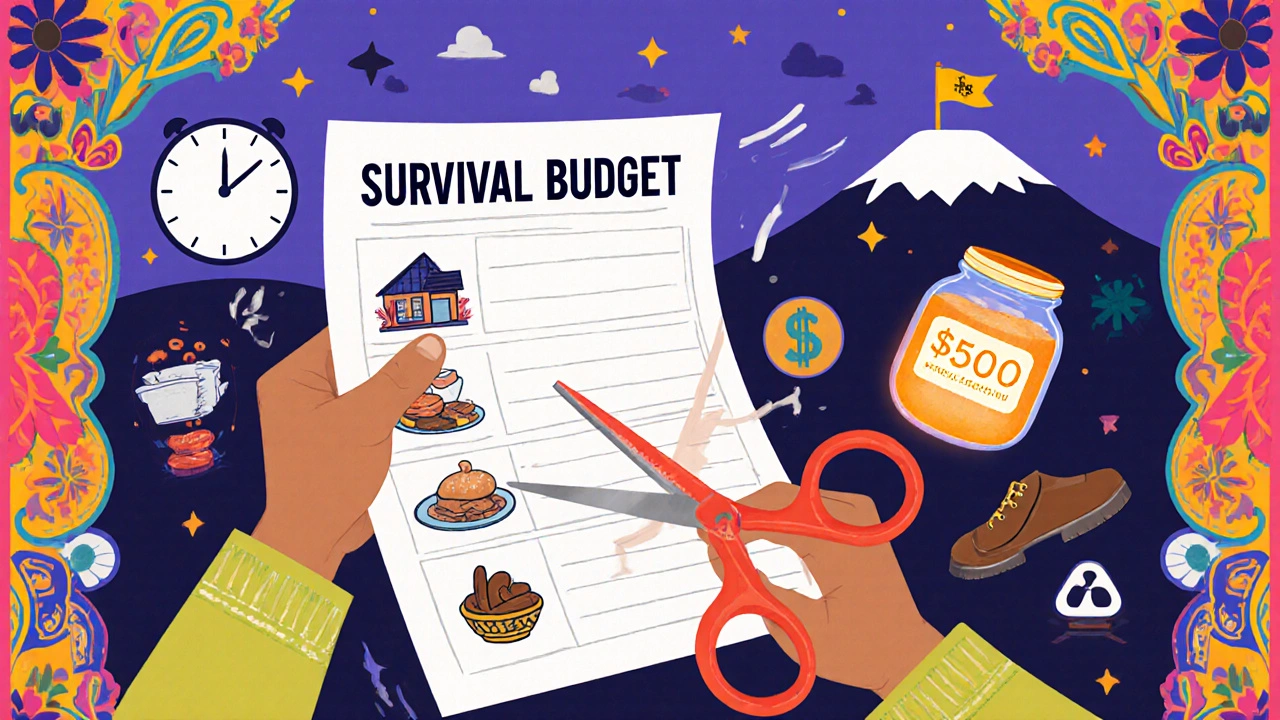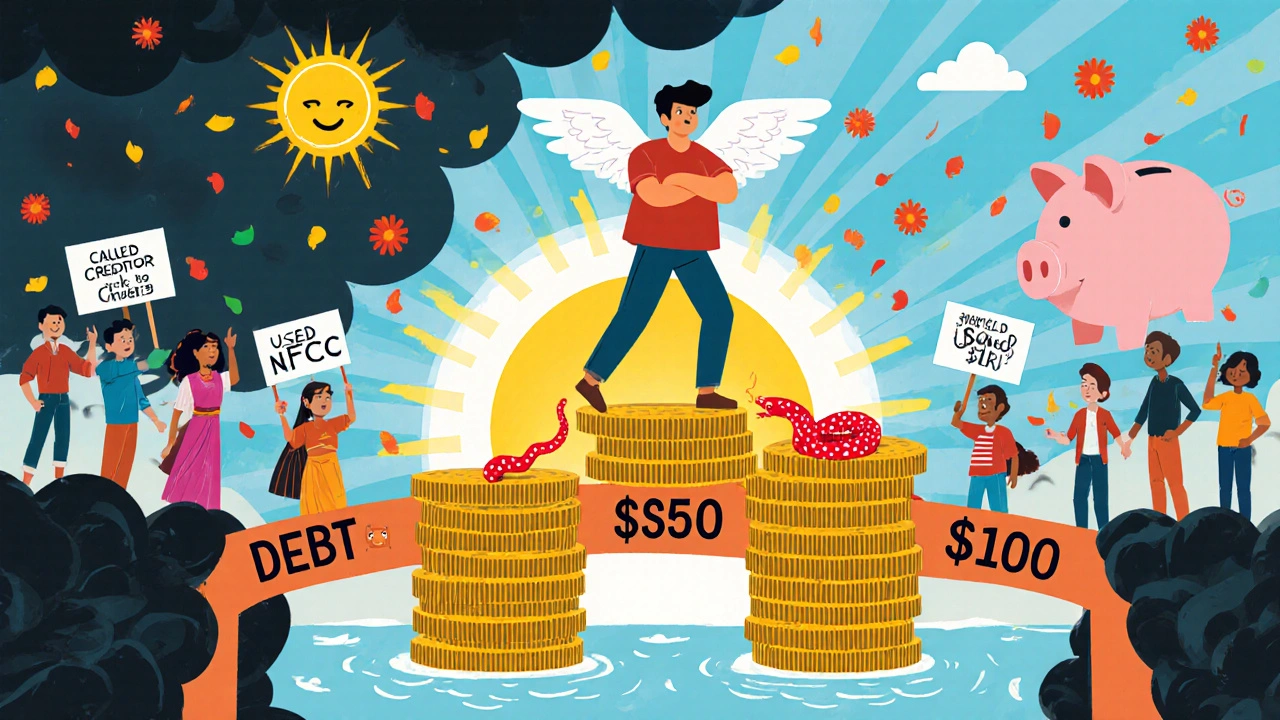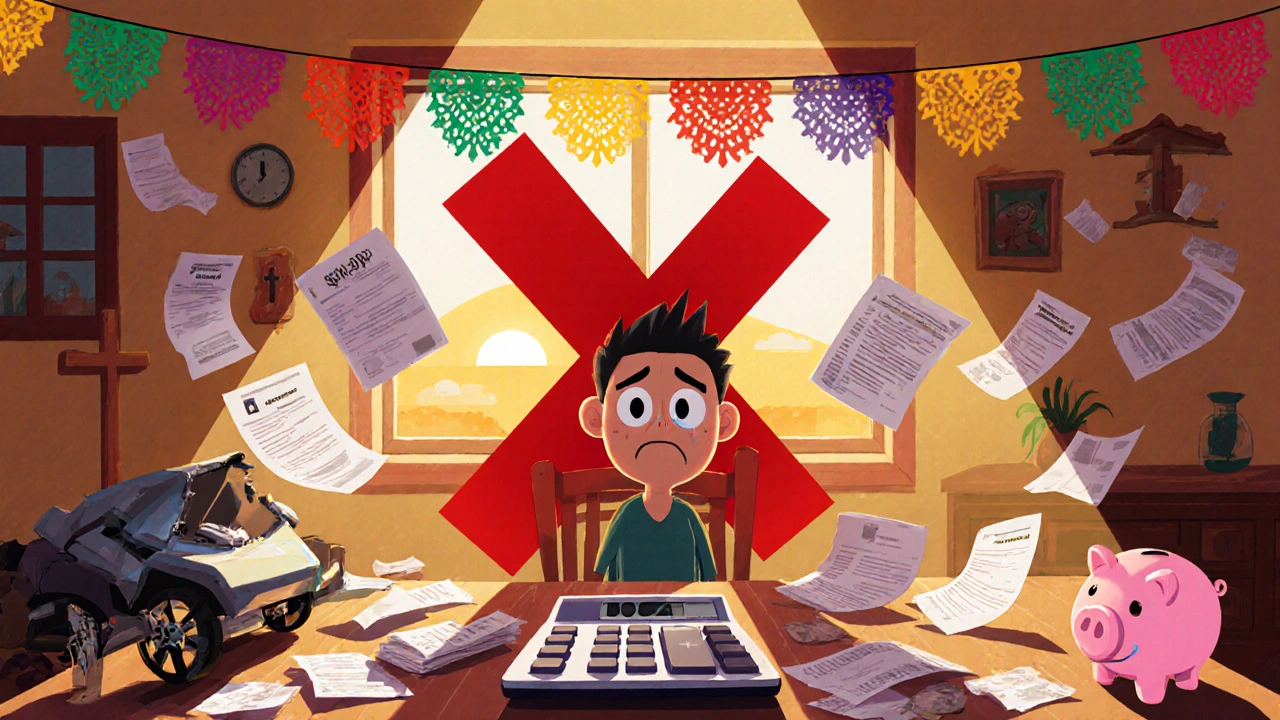Debt Payoff Calculator
Use the avalanche method to see how quickly you can eliminate debt while saving money. Enter your debts below to create your personalized repayment plan.
Your Debt Information
Your Payoff Plan
You just took a financial hit. Now what?
One unexpected bill changed everything. Maybe it was a car repair that ate up your savings. Or a medical emergency that left you with thousands in debt. Maybe you lost your job and watched your bank account drain faster than you thought possible. You’re not alone. Rebuilding after a major expense is something nearly half of American households face each year, according to the Federal Reserve. The good news? You don’t need to be rich to recover. You just need a clear plan-and the discipline to follow it.
Step 1: Take stock of what’s left
Before you can move forward, you need to know exactly where you stand. This isn’t about blaming yourself. It’s about getting real. Pull out your bank statements, credit card bills, loan statements, and investment accounts. Write down every dollar you have in savings, checking, and retirement accounts. Then list every debt you owe-credit cards, medical bills, personal loans, even that money you borrowed from your cousin.
Subtract what you owe from what you have. That number? That’s your current net worth. It might be negative. That’s okay. Many people start here. The goal isn’t to feel bad-it’s to stop guessing. A certified financial planner at Five Pines Wealth recommends tracking 37 common expense categories over the last three months. Why? Because patterns show up when you look closely. Did you spend $400 on takeout last month? Did you pay three late fees? These aren’t failures. They’re data points.
Step 2: Build a survival budget
Forget the fancy budgeting apps for now. You need a survival budget. This is the bare minimum you need to keep your lights on, your food on the table, and your rent paid. Start by listing your essential expenses: housing, utilities, groceries, basic transportation, minimum debt payments, and essential medications. Everything else? Put it on pause.
Experts at Banner Bank and First National Bank of Nebraska recommend the 50/20/10 rule-but adjusted for your situation. That means:
- 50% of your income goes to essentials
- 20% goes to paying down debt
- 10% goes to rebuilding your emergency fund
If your income dropped, adjust the percentages. Maybe it’s 60/30/10 for now. That’s fine. The point isn’t perfection-it’s control. Use the Consumer Financial Protection Bureau’s free budget worksheet. It’s simple. It works. And it doesn’t cost a dime.
Step 3: Attack your debt the smart way
Debt doesn’t disappear on its own. But how you pay it off makes a huge difference. The two most common methods are the snowball (paying smallest debts first) and the avalanche (paying highest-interest debts first). Here’s the truth: the avalanche method saves you more money. NerdWallet’s analysis of 10,000 debt repayment cases found that people using the avalanche method saved an average of $1,152 over the life of their debts compared to the snowball method.
Start by listing all your debts by interest rate-from highest to lowest. Pay the minimum on everything except the one with the highest rate. Put every extra dollar you can toward that one. When it’s gone, roll that payment over to the next one. It’s like a snowball, but one that saves you hundreds-or thousands.
And don’t wait until you’re behind. The Federal Trade Commission says if you reach out to creditors before your account hits 90 days late, you have a 73% chance of getting a modified payment plan. Call them. Be honest. Say, “I’m recovering from a major expense. Can we work out something manageable?” Most will help.

Step 4: Rebuild your emergency fund-starting with 0
This is the most important step-and the one most people skip. You think you’re done when you pay off your credit card. But without an emergency fund, one flat tire or broken appliance will send you right back into debt.
Start small. Aim for $500 to $1,000. That’s not a lot, but it’s enough to cover a car repair or a prescription co-pay without touching your credit card. Paradigm Life recommends this as your first goal. Once you hit it, you can start working toward three to six months’ worth of essential expenses. For a median U.S. household earning $74,580 a year, that’s about $18,000 to $37,000. That sounds impossible? It’s not. It just takes time.
Put $25, $50, or $100 into a separate savings account every payday. Automate it. Even if you can only save $10 a week, that’s $520 a year. That’s your first real buffer. One Reddit user, u/BudgetWarrior, paid for a $1,200 car repair with his $1,000 starter fund-and avoided $3,200 in credit card debt. That’s the power of a small fund.
Step 5: Know when to get help
You don’t have to do this alone. If you’re overwhelmed, stressed, or just don’t know where to start, reach out to a certified financial planner (CFP) or an NFCC-certified credit counselor. These aren’t salespeople. They’re trained professionals who help people rebuild after setbacks like yours.
The Financial Planning Association’s 2023 study found that 68% of people who worked with a counselor saw real improvement in their finances within six months. And the NFCC handles over 1.2 million calls a year-24/7. Their services are free or low-cost. You can find one near you through their website.
Don’t wait until you’re drowning. The earlier you get help, the faster you recover. And if you’re dealing with medical debt, housing issues, or unemployment, HUD-approved housing counselors and local nonprofit agencies can connect you with resources you didn’t even know existed.
Why this works better than winging it
People who try to recover on their own-without a plan-take twice as long to get back on track. A 2022 meta-analysis in the Journal of Consumer Affairs found that those following a structured plan recovered 87% faster than those who didn’t. They also paid off 23% more debt within a year, according to the Federal Reserve Bank of New York.
And it’s not just about money. The American Psychological Association found that people using a clear recovery plan reported 41% less financial stress. That matters. Stress makes you make worse decisions. A plan gives you back control.
What doesn’t work
Debt consolidation loans sound tempting. But they often come with high interest rates-around 18.9% on average, according to the CFPB. You’re not solving the problem. You’re just moving it around.
Same with “financial gurus” who promise quick fixes. There’s no magic button. Recovery takes time, consistency, and honesty. And if your income is below the federal poverty level ($14,580 for a single person in 2024), you may need government help-SNAP, Medicaid, unemployment, or housing assistance. That’s not failure. That’s using the system designed to help you.

Real people, real results
On Reddit’s r/personalfinance, over 200 people shared stories of recovering from $20,000 in medical debt. On average, it took them 18.7 months. They didn’t win the lottery. They didn’t get a huge raise. They stuck to their plan. One person paid off $28,000 in debt by cutting cable, cooking at home, selling old stuff, and working a side gig. They didn’t quit their job. They just changed how they spent.
On the flip side, the people who didn’t recover? They usually faced multiple setbacks at once-job loss + medical bill + car trouble. That’s why building your emergency fund isn’t optional. It’s your insurance policy.
Tools that make it easier
- CFPB’s Debt Payoff Calculator - Free, no sign-up needed. Shows you exactly how long it’ll take to pay off each debt.
- Mint or Zing Credit Union’s Recovery Roadmap - Tracks spending and flags unexpected costs before they hurt you.
- NFCC Hotline - Call 1-800-388-2227 for free, confidential counseling.
- Spreadsheet templates - Download free ones from Five Pines Wealth or the CFPB. Use them to track every dollar.
What to expect in the next 6 months
By month 2: You’ve cut unnecessary spending. You’ve called your creditors. You’ve opened a separate savings account.
By month 4: You’ve paid off one credit card. Your starter emergency fund is at $1,000. You’re sleeping better.
By month 6: Your credit score has jumped 19 points on average, according to the National Endowment for Financial Education. You’re no longer scared to open your bank app.
This isn’t about becoming rich. It’s about becoming steady. About knowing that if another emergency hits, you won’t spiral.
Final thought: Progress, not perfection
Dr. Robert Pagliarini from Pacific Park Financial warns that overly rigid timelines cause 28% of people to quit. So don’t beat yourself up if you miss a savings goal. Don’t panic if your car breaks down again. This isn’t a race. It’s a reset.
Every dollar you save. Every debt you pay. Every time you say no to an impulse buy-you’re rebuilding your future. Slowly. Surely. And it’s working.

Julia Czinna
October 31, 2025 AT 09:14Also, calling creditors before you’re late? Game changer. One rep even waived my late fee because I said I was rebuilding. People forget they’re humans too.
Laura W
November 1, 2025 AT 08:11Graeme C
November 1, 2025 AT 18:07Also, the $500 starter fund? That’s not a suggestion-it’s a survival tactic. One car repair later and you’re back in the hole without it. Period.
Astha Mishra
November 2, 2025 AT 01:30